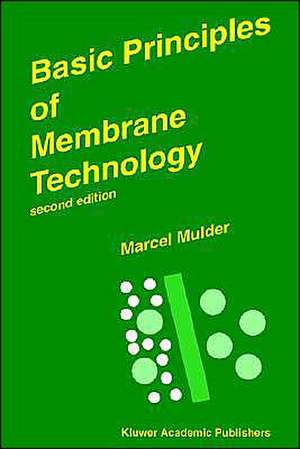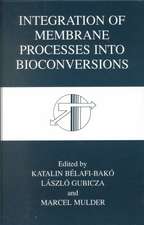Basic Principles of Membrane Technology
Autor Marcel Mulderen Limba Engleză Paperback – 30 sep 1996
| Toate formatele și edițiile | Preț | Express |
|---|---|---|
| Paperback (1) | 2422.68 lei 6-8 săpt. | |
| SPRINGER NETHERLANDS – 30 sep 1996 | 2422.68 lei 6-8 săpt. | |
| Hardback (1) | 2430.26 lei 6-8 săpt. | |
| SPRINGER NETHERLANDS – 30 sep 1996 | 2430.26 lei 6-8 săpt. |
Preț: 2422.68 lei
Preț vechi: 2954.48 lei
-18% Nou
Puncte Express: 3634
Preț estimativ în valută:
463.59€ • 485.00$ • 385.10£
463.59€ • 485.00$ • 385.10£
Carte tipărită la comandă
Livrare economică 02-16 aprilie
Preluare comenzi: 021 569.72.76
Specificații
ISBN-13: 9780792342489
ISBN-10: 0792342488
Pagini: 564
Ilustrații: XIV, 564 p.
Dimensiuni: 160 x 240 x 33 mm
Greutate: 0.8 kg
Ediția:2nd ed. 1996. Softcover reprint of the original 2nd ed. 1996
Editura: SPRINGER NETHERLANDS
Colecția Springer
Locul publicării:Dordrecht, Netherlands
ISBN-10: 0792342488
Pagini: 564
Ilustrații: XIV, 564 p.
Dimensiuni: 160 x 240 x 33 mm
Greutate: 0.8 kg
Ediția:2nd ed. 1996. Softcover reprint of the original 2nd ed. 1996
Editura: SPRINGER NETHERLANDS
Colecția Springer
Locul publicării:Dordrecht, Netherlands
Public țintă
ResearchCuprins
I Introduction.- I. 1 Separation processes.- I. 2 Introduction to membrane processes.- I. 3 History.- I. 4 Definition of a membrane.- I. 5 Membrane processes.- I. 6 Solved problems.- I. 7 Unsolved problems.- I. 8 Literature.- II Materials and material properties.- II. 1 Introduction.- II. 2 Polymers.- II. 3 Stereoisomerism.- II. 4 Chain flexibility.- II. 5 Molecular weight.- II. 6 Chain interactions.- II. 7 State of the polymer.- II. 8 Effect of polymeric structure on Tg.- II. 9 Glass transition temperature depression.- II. 10 Thermal and chemical stability.- II. 11 Mechanical properties.- II. 12 Elastomers.- II. 13 Thermoplastic elastomers.- II. 14 Polyelectrolytes.- II. 15 Polymer blends.- II. 16 Membrane polymers.- II. 17 Inorganic membranes.- II. 18 Biological membranes.- II. 19 Solved problems.- II. 20 Unsolved problems.- II. 21 Literature.- III Preparation of synthetic membranes.- III. 1 Introduction.- III. 2 Preparation of synthetic membranes.- III. 3 Phase inversion membranes.-III.4 Preparation techniques for immersion precipitation.- III.5 Preparation techniques for composite membranes.- III.6 Phase separation in polymer systems.- III.7 Influence of various parameters on membrane morphology.- III. 8 Inorganic membranes.- III.9 Solved problems.- III.10 Unsolved problems.- III. 11 Literature.- IV Characterisation of membranes.- IV. 1 Introduction.- IV. 2 Membrane characterization.- IV. 3 Characterisation of porous membranes.- IV. 4 Characterisation of ionic membranes.- IV. 5 Characterisation of nonporous membranes.- IV. 6 Solved problems.- IV. 7 Unsolved problems.- IV. 8 Literature.- V Transport in membranes.- V. 1 Introduction.- V. 2 Driving forces.- V. 3 Nonequilibrium thermodynamics.- V. 4 Transport through porous membranes.- V. 5 Transport through nonporous membranes.- V. 6 Transport through membranes. A unified approach.- V. 7 Transport in ion-exchange membranes.- V. 8 Solved problems.- V. 9 Unsolved problems.- V. 8 Literature.- VI Membrane processes.-VI. 1 Introduction.- VI. 2 Osmosis.- VI. 3 Pressure driven membrane processes.- VI. 4 Concentration as driving force.- VI. 5 Thermally driven membrane processes.- VI. 6 Membrane contactors.- VI. 7 Electrically driven membrane processes.- VI. 8 Membrane reactors and membrane bioreactors.- VI. 9 Solved problems.- VI. 10 Unsolved problems.- VI. 11 Literature.- VII Polarisation phenomena and fouling.- VII. 1 Introduction.- VII. 2 Concentration polarisation.- VII. 3 Turbulence promoters.- VII. 4 Pressure drop.- VII. 5 Characteristic flux behaviour in pressure driven membrane operations.- VII. 6 Gel layer model.- VII. 7 Osmotic pressure model.- VII. 8 Boundary layer resistance model.- VII. 9 Concentration polarisation in diffusive membrane separations.- VII. 10 Concentration polarisation in electrodialysis.- VII. 11 Temperature polarization.- VII. 12 Membrane fouling.- VII. 13 Methods to reduce fouling.- VII. 14 Compaction.- VII. 15 Solved problems.- VII. 16 Unsolved problems.- VII. 17 Literature.- VIII Module and process design.- VIII. 1 Introduction.- VIII. 2 Plate-and-frame model.- VIII. 3 Spiral wound module.- VIII. 4 Tubular module.- VIII. 5 Capillary module.- VIII. 6 Hollow fiber module.- VIII. 7 Comparison of the module configurations.- VIII. 8 System design.- VIII. 9 Cross-flow operations.- VIII. 10 Hybrid dead-end/cross flow system.- VIII. 11 Cascade operations.- VIII. 12 Some examples of system design.- VIII. 13 Process parameters.- VIII. 14 Reverse osmosis.- VIII. 15 Diafiltration.- VIII. 16 Gas separation and vapour permeation.- VIII. 17 Pervaporation.- VIII. 18 Pervaporation.- VIII. 19 Dialysis.- VIII. 20 Energy requirements.- VIII. 21 Solved problems.- VIII. 22 Unsolved problems.- VIII. 23 Literature.- Appendix 1.- Appendix 2.- Answers to exercises: solved problems.- Answers to exercises: unsolved problems.- List of symbols.










